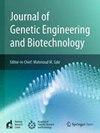In silico exploration of biosynthetic gene clusters in marine Streptomyces sp. and Nocardiopsis sp. from the western coast of India: Genome-based profiling using whole genome sequencing
IF 2.8
Q3 Biochemistry, Genetics and Molecular Biology
Journal of Genetic Engineering and Biotechnology
Pub Date : 2025-03-25
DOI:10.1016/j.jgeb.2025.100483
引用次数: 0
Abstract
Actinomycetes are known for their ability to produce bioactive compounds with significant potency of antibiotics and natural product synthesis. With the growing threat of antimicrobial resistance, effective treatment for many infections has become increasingly challenging. Our study aims to explore the secondary metabolites produced by Actinomycetes isolated from marine sponge samples collected from the west coast of India using in silico approaches. The pre-processed high-throughput Illumina sequencing reads from six Actinomycete genomes showed high quality. Initial BLAST analysis followed by phylogenetic analysis revealed that isolates A01 and A96 closely matched Nocardiopsis sp., while isolates A03, A45, A57, and A90 were closely related to Streptomyces sp. In silico biosynthetic gene clusters (BGC) prediction indicated that Streptomyces sp. A57 had the highest number of BGCs, with 28 clusters identified. All Streptomyces sp. (A03, A45, A57, and A90) were predicted to contain a high number of terpene gene clusters. Ectoine was commonly found in all genomes of Streptomyces sp. and Nocardiopsis sp. Most of the BGCs identified in Actinomycete genomes revealed less similarity to the known BGCs, indicating their potential for producing novel secondary metabolites. The study reveals the genomic potential of the Actinomycetes by providing new insights into the ecological roles and potential applications of marine Actinomycetes, highlighting their promise as candidates for the discovery of new pharmaceuticals. Future investigations could benefit from integrating functional genomics and metabolomics to gain deeper insights into the metabolic pathways governing the biosynthesis of these secondary metabolites.
印度西海岸海洋链霉菌和诺卡多菌生物合成基因簇的计算机探索:使用全基因组测序的基因组分析
放线菌以其产生具有显著抗生素效力和天然产物合成的生物活性化合物的能力而闻名。随着抗菌素耐药性的威胁日益严重,对许多感染进行有效治疗变得越来越具有挑战性。我们的研究旨在利用计算机方法探索从印度西海岸采集的海绵样品中分离的放线菌产生的次生代谢物。6个放线菌基因组的预处理高通量Illumina测序结果显示高质量。初步BLAST分析和系统发育分析显示,分离株A01和A96与Nocardiopsis sp.匹配度较高,而分离株A03、A45、A57和A90与Streptomyces sp.亲缘关系较近。在硅生物合成基因簇(BGC)预测中,链霉菌A57的BGC数量最多,共鉴定出28个簇。所有链霉菌(A03、A45、A57和A90)均含有大量萜烯基因簇。链霉菌(Streptomyces sp.)和诺卡多菌(Nocardiopsis sp.)的所有基因组中都发现了异托碱。在放线菌基因组中发现的大多数BGCs与已知BGCs的相似性较低,表明它们具有产生新的次级代谢物的潜力。该研究揭示了放线菌的基因组潜力,为海洋放线菌的生态作用和潜在应用提供了新的见解,突出了它们作为新药物发现候选者的前景。未来的研究可能受益于整合功能基因组学和代谢组学,以更深入地了解控制这些次生代谢物生物合成的代谢途径。
本文章由计算机程序翻译,如有差异,请以英文原文为准。
求助全文
约1分钟内获得全文
求助全文
来源期刊

Journal of Genetic Engineering and Biotechnology
Biochemistry, Genetics and Molecular Biology-Biotechnology
CiteScore
5.70
自引率
5.70%
发文量
159
审稿时长
16 weeks
期刊介绍:
Journal of genetic engineering and biotechnology is devoted to rapid publication of full-length research papers that leads to significant contribution in advancing knowledge in genetic engineering and biotechnology and provide novel perspectives in this research area. JGEB includes all major themes related to genetic engineering and recombinant DNA. The area of interest of JGEB includes but not restricted to: •Plant genetics •Animal genetics •Bacterial enzymes •Agricultural Biotechnology, •Biochemistry, •Biophysics, •Bioinformatics, •Environmental Biotechnology, •Industrial Biotechnology, •Microbial biotechnology, •Medical Biotechnology, •Bioenergy, Biosafety, •Biosecurity, •Bioethics, •GMOS, •Genomic, •Proteomic JGEB accepts
 求助内容:
求助内容: 应助结果提醒方式:
应助结果提醒方式:


